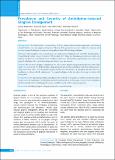Please use this identifier to cite or link to this item:
https://hdl.handle.net/20.500.14356/2308Full metadata record
| DC Field | Value | Language |
|---|---|---|
| dc.contributor.author | Rajkarnikar, Junima | - |
| dc.contributor.author | Dahal, Samarika | - |
| dc.contributor.author | Vaidya, Samriddhi | - |
| dc.contributor.author | Ghimire, Pratikshya | - |
| dc.date.accessioned | 2023-07-31T06:45:56Z | - |
| dc.date.available | 2023-07-31T06:45:56Z | - |
| dc.date.issued | 2022 | - |
| dc.identifier.citation | Rajkarnikar J., DahalS., VaidyaS., & GhimireP. (2023). Prevalence and Severity of Amlodipine-induced Gingival Enlargement. Journal of Nepal Health Research Council, 20(4), 962-966. https://doi.org/10.33314/jnhrc.v20i4.4363 | en_US |
| dc.identifier.issn | Print ISSN: 1727-5482; Online ISSN: 1999-6217 | - |
| dc.identifier.uri | https://hdl.handle.net/20.500.14356/2308 | - |
| dc.description | Original Article | en_US |
| dc.description.abstract | Abstract Background: The administration of several classes of drugs; anticonvulsants, immunosuppressants, and calcium channel blockers can cause gingival enlargement. The aim of the present study was to evaluate the frequency and severity of gingival enlargement in patients taking calcium channel blocker drug amlodipine. Methods: This descriptive cross-sectional study was conducted on 250 patients who visited the dental hospital at Nepal Medical College between November 2021 to April 2022. Using the Bokenkamp and Bornhorst Index, the patients who had been on amlodipine for at least three months were examined for gingival enlargement. Along with gingival and plaque index, medication dosage and duration were also assessed. Results: The prevalence of gingival enlargement was 37%. Grade 1 gingival enlargement was present in 18% while grade 3 was seen in only 2%. Both individuals taking amlodipine alone and in combination with other antihypertensive drugs showed the same level of gingival enlargement. The dose and duration of amlodipine ingestion showed a significant correlation with the enlargement. The gingival and plaque index also showed a strong correlation with overgrowth. Conclusions: The physicians prescribing amlodipine should well inform the patients about the potential side effects. In such cases, the maintenance of oral hygiene should be prioritized from the beginning. In severe cases, substitution of the drugs followed by oral therapeutic measures should be considered for complete regression. Keywords: Amlodipine; gingival enlargement; prevalence; periodontology | en_US |
| dc.language.iso | en | en_US |
| dc.publisher | Government of Nepal; Nepal Health Research Council; Ramshah Path, Kathmandu, Nepal | en_US |
| dc.relation.ispartofseries | Oct-Dec, 2022;4363 | - |
| dc.subject | Amlodipine | en_US |
| dc.subject | Gingival enlargement | en_US |
| dc.subject | Prevalence | en_US |
| dc.subject | Periodontology | en_US |
| dc.title | Prevalence and Severity of Amlodipine-induced Gingival Enlargement | en_US |
| dc.type | Journal Article | en_US |
| Appears in Collections: | Vol 20 No 04 Issue 57 Oct-Dec, 2022 | |
Files in This Item:
| File | Description | Size | Format | |
|---|---|---|---|---|
| 4363-Manuscript-32214-1-10-20230725.pdf | Fulltext. | 271.71 kB | Adobe PDF |  View/Open |
Items in DSpace are protected by copyright, with all rights reserved, unless otherwise indicated.
